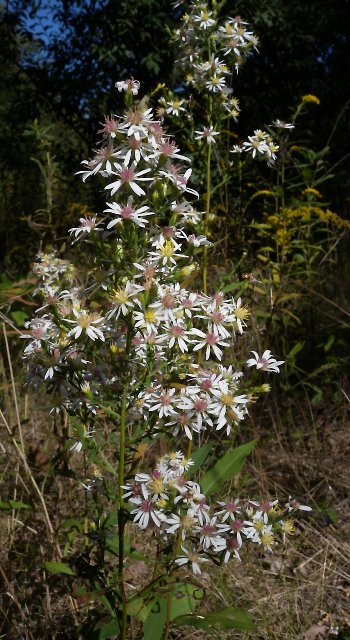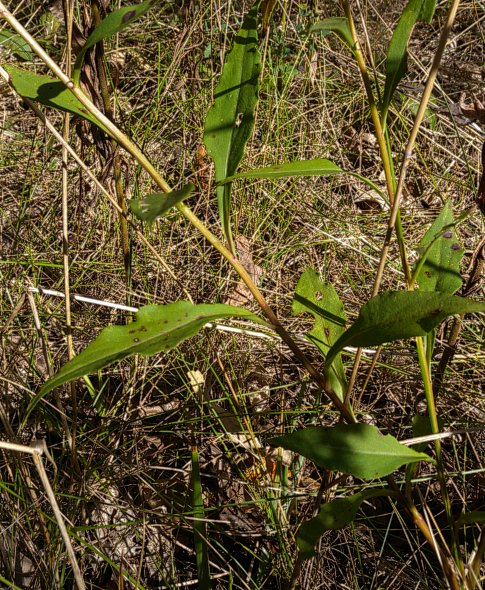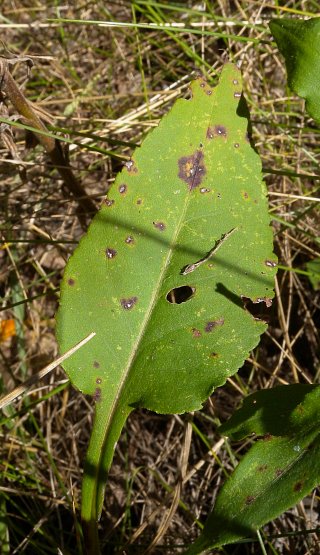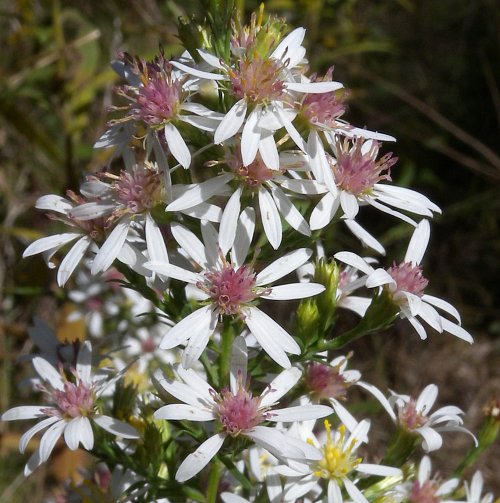
Uppermost alternate leaves are often sessile or nearly so. The middle to uppermost alternate leaves have margins that are slightly toothed or toothless (entire). The teeth of all leaves, when they are present, are crenate to serrate. The upper leaf surface is dull medium green and sparsely covered with short stiff hairs, while the lower leaf surface is hairy primarily along the major veins. With age, some leaves may lose their hairs. The central stem and any upper secondary stems terminate in panicles of flowerheads about ½–1½' long and about one-half to one-third as much across. Together, these inflorescences often resemble a compound panicle of flowerheads. Individual flowerheads are about ½" (12 mm.) across, consisting of 8-12 pistillate ray florets that surround a dense head of 10-15 perfect disk florets. The petaloid rays are widely spreading, narrowly oblong in shape, and usually white (rarely lavender). The corollas of the disk florets are up to 5 mm. (nearly ¼") long and narrowly tubular with 5 uppers lobes; they are initially yellow, but later become pink or light purple.

The base of each flowerhead is surrounded by phyllaries (scale-like floral bracts) in several overlapping series. Individual phyllaries are greenish, linear-lanceolate in shape, and variable in size; they are appressed together or slightly spreading. The midsections of these phyllaries are dark green and linear in shape throughout; the tips of these phyllaries taper gradually into narrow stiff tips. The branches of each inflorescence and peduncles of the flowerheads are light green and sparsely hairy. Along the branches of each inflorescence, there are leafy bracts up to 1" long that are linear to narrowly elliptic in shape. The blooming period occurs from late summer to mid-autumn, lasting about 1 month for a colony of plants. Afterwards, the florets are replaced by achenes with small tufts of whitish hair; they are distributed by the wind. Individual achenes are about 2 mm. long, ellipsoid-oblongoid, slightly compressed, purplish brown or brown, and longitudinally ribbed. The root system is fibrous and short-rhizomatous; older plants often develop a small woody caudex. Sometimes, clonal offsets develop from the rhizomes.

Cultivation: This plant prefers full or partial sunlight and mesic to dry conditions. A variety of soil types are tolerated, including those that contain loam, clay-loam, sandy-loam, or rocky material. This plant is not difficult to cultivate, although it should be watered during hot dry spells of the summer.
Range & Habitat: White Arrowleaf Aster is occasional throughout Illinois (see Distribution Map). This map is derived from information in Jones (1989). Habitats include upland savannas, sandy savannas, woodland edges, small meadows in upland areas, rocky glades, thickets, abandoned fields, roadsides, and areas near railroads. This plant is found in both high quality and disturbed habitats. It probably benefits from occasional fires in wooded areas, or other kinds of disturbance that thin-out the tree canopy.

Faunal Associations: The nectar and pollen of the flowerheads attract a wide variety of insects, including long-tongued bees, short-tongued bees, bee flies (Bombyliidae), wasps, butterflies, and skippers. Aster species (Symphyotrichum spp.) require cross-pollination from these insects in order to produce fertile seeds. The caterpillars of a butterfly, Phyciodes tharos (Pearl Crescent), feed on the leaves of asters, especially smooth-leaved species. The larvae of many moth species feed on the foliage and other parts of asters (see Moth Table), as do the larvae and adults of many other insects (see Insect Table), including leaf beetles, lace bugs, plant bugs, stink bugs, aphids, leafhoppers, larvae of leaf-mining flies, larvae of fruit flies, and grasshoppers. Some vertebrate animals use aster species as a source of food. For example, the Wild Turkey and Ruffed Grouse feed on the seeds and young foliage. Deer, rabbits, groundhogs, and many domesticated farm animals also feed on the foliage, particularly when it is young.
Photographic Location: An upland meadow at Moraine View State Park in McLean County, Illinois.

Comments: White Arrowleaf Aster has a history of taxonomic instability. It has been regarded as a variety of Symphyotrichum cordifolium (Heart-leaved Aster) and Symphyotrichum sagittifolium (Arrow-leaved Aster) in the past. It is also similar to Symphyotrichum drummondii (Drummond's Aster). Some taxonomists consider Symphyotrichum sagittifolium to be a synonym for Symphyotrichum urophyllum, however A.G. Jones (1989) ultimately separated them taxonomically. White Arrowleaf Aster can be considered distinct from the preceding aster species in this group by the following characteristics: 1) the petaloid rays of this aster are usually white, rather than lavender, 2) the alternate leaves of this aster tend to be more narrow in shape, 3) the phyllaries of this aster have midsections that are dark green and linear in shape throughout their length, rather than narrowly diamond-shaped and dark green toward their tips, and 4) the phyllaries of this aster tend to have tips that are more tapered and stiff. White Arrowleaf Aster is also less hairy than Drummond's Aster. A scientific synonym of White Arrowleaf Aster is Aster urophyllus.